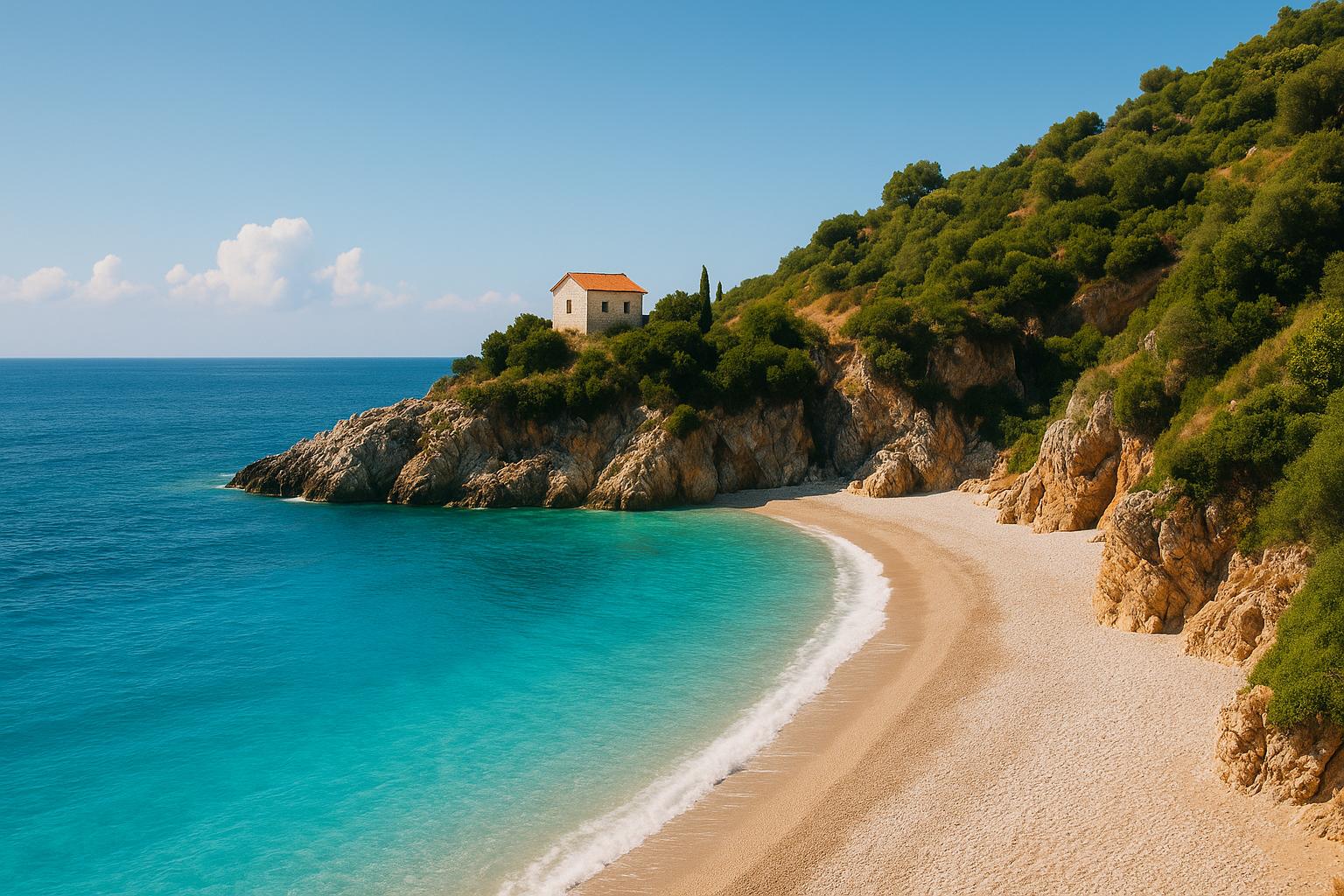Tirana is facing urban challenges tied to rapid growth, with a population nearing 1 million. To tackle issues like air pollution, insufficient green spaces, and waste management, the city has launched the Green City Action Plan (GCAP). This initiative, developed with the European Bank for Reconstruction and Development (EBRD), aims to improve living conditions by focusing on cleaner air, better water management, and urban greenery.
Key goals include:
- More Green Spaces: Transforming unused areas into parks, creating green corridors, and introducing community gardens.
- Sustainable Transport: Expanding electric public transport, bike lanes, and pedestrian zones.
- Improved Waste and Water Systems: Boosting recycling, reducing illegal dumping, and upgrading water infrastructure.
- Cleaner Air: Monitoring emissions, planting trees, and adopting green building standards.
The GCAP aligns with Tirana’s 2016 TIRANA2030 plan and supports Albania’s climate goals, including reducing CO2 emissions by 20.9% by 2030. These efforts also contribute to global frameworks like the Paris Agreement and UN Sustainable Development Goals. For residents and visitors alike, these changes promise a healthier, greener, and more livable city.
Dr. Frida Pashako, Head of Urban Planning Department, Municipality of Tirana - FABER
Main Challenges Addressed by the GCAP
The GCAP tackles pressing environmental concerns in Tirana, many of which stem from the city's rapid and unplanned urban expansion following significant domestic migration since 1990. Among the most pressing issues are overburdened waste management systems and declining water quality. To address these, the GCAP lays out specific strategies for improving both waste handling and water management.
Waste Management and Water Quality
When it comes to waste management, Tirana is playing catch-up with its urban growth. The current system heavily relies on landfilling, with minimal recycling efforts and limited household waste separation. To change this, the GCAP proposes a series of reforms, including performance-based contracts and the creation of Local Integrated Waste Management Plans. These plans aim to introduce modern recycling technologies and set ambitious recycling goals for municipal and packaging waste. They also focus on improving household waste collection by ensuring proper separation into categories like non-recyclable, recyclable, mixed recyclables, and organic materials.
Water quality is another critical area of concern. Problems like inefficient resource management and aging infrastructure have led to significant challenges. The GCAP addresses these by targeting reductions in non-revenue water losses, which helps optimize water use. Additionally, the plan emphasizes expanding access to clean drinking water throughout the city.
To engage the public, the "My Tirana" app allows citizens to report waste management issues and environmental pollution directly to the authorities. On top of that, door-to-door collection services for bulky household items - such as furniture, mattresses, and electronics - help curb illegal dumping and keep neighborhoods cleaner.
Core Goals and Priority Actions
The GCAP zeroes in on expanding green spaces, encouraging sustainable transport, and enhancing air and water quality in Tirana.
Expanding Urban Green Spaces
The plan places a strong emphasis on developing parks, green corridors, and recreational areas to address urban heat and improve residents' access to nature. It's not just about adding more green spaces but also ensuring they are thoughtfully designed and maintained.
A key focus is creating interconnected green corridors that link existing and new parks. These corridors aim to lower urban temperatures, boost air quality, and provide safe pathways for pedestrians and cyclists.
The initiative also encourages community-managed gardens and green spaces, empowering residents to take an active role in shaping their neighborhoods while fostering a deeper connection to the environment.
Unused urban areas - like vacant lots, abandoned industrial zones, and idle public land - are identified as prime opportunities for transformation into green spaces. This approach makes efficient use of limited space in the city's dense urban areas, turning neglected spots into vibrant community assets.
Promoting Better Transportation
Reducing emissions and easing congestion are central to the GCAP's transportation goals, with a strong push towards sustainable alternatives to private cars.
The plan accelerates the adoption of electric public transport and expands infrastructure for cycling, including protected bike lanes, secure parking, and bike-sharing programs. These measures aim to make cycling a practical and attractive choice for more residents.
Creating pedestrian-friendly spaces is another priority. This involves widening pavements, improving street lighting, designating pedestrian-only zones, and ensuring better connectivity between residential and commercial areas. These changes make walking not only safer but also more enjoyable, while supporting local businesses and fostering community interaction.
Traffic management strategies complement these efforts. The GCAP includes measures like reducing congestion in busy areas, implementing smart traffic systems, and introducing car-free zones during specific times or events to improve urban mobility.
Improving Air and Water Quality
The GCAP also tackles environmental quality with a focus on air, water, and noise pollution.
To enhance air quality, the plan relies on rigorous monitoring, stricter industrial emissions controls, expanding tree coverage, and adopting green building standards.
Water quality improvements are approached through initiatives like rainwater harvesting, groundwater protection, and sustainable drainage systems. These measures aim to ensure cleaner water sources while reducing the risk of flooding.
Noise pollution is addressed through strategic urban planning, including the use of green barriers along major roads and tighter regulations on construction activities. These steps complement air quality improvements, creating a more pleasant and livable urban environment.
Lastly, the plan enforces stricter controls on industrial pollution, requiring businesses to adopt cleaner production methods and proper waste disposal practices. These efforts protect both air and water quality, contributing to a healthier city for all.
Impact on Urban Green Spaces
The GCAP's strategic goals have left a noticeable mark on Tirana's urban green spaces, redefining the city's approach to development. These efforts are improving biodiversity, promoting healthier lifestyles, and creating more vibrant urban environments.
Improvements in Public Parks and Recreation
Unused land and neglected industrial areas are being transformed into a network of green spaces, thanks to the GCAP. These spaces now serve as safe corridors for pedestrians and cyclists while also improving habitats for urban wildlife. Vacant lots have been turned into pocket parks filled with native Albanian plants, offering much-needed green retreats in the city. These parks are thoughtfully designed to cater to all age groups, featuring children's play zones, outdoor fitness equipment, walking paths, and spaces for community gatherings. Existing parks aren’t left out either - they’re being upgraded with better maintenance, improved lighting, and accessible facilities to ensure safety and usability for everyone.
Community and Health Benefits
The ripple effects of these green space projects are evident in the community's well-being. Expanded greenery plays a role in filtering air pollutants, contributing to better physical health. At the same time, these spaces provide a calming environment, supporting mental health. Local residents are getting involved in maintaining community gardens and green areas, fostering a sense of pride and responsibility. The reintroduction of native plants is also helping urban wildlife, like birds and pollinators, thrive, which in turn boosts biodiversity. There’s even evidence suggesting that these enhancements are making neighborhoods more appealing, potentially benefiting local businesses and property values.
Before and After Comparison
The transformation brought by the GCAP is clear when comparing the city before and after these initiatives. Previously overlooked areas now boast increased green space, and residents are actively using the new facilities. The improved connectivity between parks not only supports ecological processes but also provides safer routes for walking and cycling, reducing reliance on busy streets.
For those visiting Tirana through Discover Albania (https://albaniatravel.guide), these revitalized green spaces add a new layer of charm to the city. They offer visitors more opportunities for outdoor activities, complementing Tirana’s rich cultural and historical attractions.
sbb-itb-dfcc1b7
Connection with Other Policies and Frameworks
Tirana's Green City Action Plan (GCAP) isn't a standalone effort. It's intricately linked to a network of local, national, and international policies, creating a cohesive strategy to advance environmental goals while supporting broader development objectives.
Alignment with Local and National Policies
The GCAP aligns seamlessly with Tirana's 2016 General Local Plan, TIRANA2030. This connection ensures that the city's green initiatives are fully integrated into its long-term urban development vision. By focusing on areas like transport, green infrastructure, resource management, and urban resilience, the GCAP complements the broader goals of TIRANA2030. Instead of duplicating efforts or creating conflicting priorities, these plans work together to promote sustainable growth.
On a national level, the GCAP plays a key role in helping Albania meet its climate commitments. In 2021, Albania updated its Nationally Determined Contributions (NDCs) under the Paris Agreement, pledging to reduce CO2 emissions by 20.9% by 2030, compared to 2016 levels. Tirana's efforts to expand green spaces and promote sustainable transport directly support this target by reducing emissions and increasing carbon absorption.
The GCAP also aligns with Albania's National Adaptation Plan (NAP), which outlines strategies to address climate change impacts on vulnerable sectors like agriculture, tourism, and urban development. Tirana addresses these concerns by implementing local measures to improve urban resilience. Initiatives like enhancing green spaces to combat heat and improving water management illustrate how the city is tackling climate adaptation challenges head-on.
International Framework Connections
Tirana's GCAP extends its influence beyond local and national boundaries, contributing to global sustainability efforts. It directly supports the United Nations Sustainable Development Goals (SDGs), particularly SDG 11: Sustainable Cities and Communities.
For instance, the transformation of Tirana's central square highlights the city's commitment to SDG 11.7, which emphasizes creating inclusive and accessible public spaces. Similarly, the ambitious "Orbital Forest" project reflects international priorities. Between 2017 and 2018, Tirana planted 122,000 trees, aiming for a total of 2,000,000 trees by 2030. This initiative helps curb urban sprawl, supports biodiversity, and addresses climate challenges, aligning with the Paris Agreement and SDG 11.B.
Transportation improvements are another area of international alignment. By adding 36 kilometres of bike lanes by December 2023 and planning an additional 11 kilometres by mid-2019, Tirana is addressing air pollution and traffic congestion. These efforts contribute to what urban planners describe as "co-benefits for air quality and climate", further supporting the goals of the Paris Agreement.
The city's focus on small green spaces, such as "pocket parks," is equally impactful. Tirana has doubled their number to 70, covering a total of 200 square metres, which represents 8 to 10 percent of the city's locally-administered area. These parks not only enhance urban greenery but also support multiple SDG targets, demonstrating how limited urban space can be optimized for environmental gains.
Through these efforts, Tirana's GCAP illustrates how local actions can drive progress on multiple levels - serving residents, advancing national climate objectives, and contributing to global sustainability initiatives. By connecting local improvements to broader frameworks, the plan exemplifies how cities can tackle climate and development challenges in an integrated and impactful way.
Conclusion and Key Points
The Green City Action Plan (GCAP) is reshaping how Tirana addresses urban challenges, focusing on improving the environment and quality of life. By tackling issues like air pollution, limited green spaces, and inefficient waste management, the plan introduces practical solutions that benefit both the city's residents and its natural surroundings.
Key initiatives such as widespread tree planting, the creation of pocket parks, and better cycling infrastructure have a direct impact on air quality, reduce urban heat, and provide more opportunities for recreation.
But the benefits don’t stop there. These changes are redefining Tirana’s urban identity, making it a more appealing and livable city. By aligning with TIRANA2030 and national climate goals, the city is ensuring that local efforts contribute to broader global objectives, like the UN Sustainable Development Goals and the Paris Agreement.
For visitors exploring Tirana through platforms like Discover Albania (https://albaniatravel.guide), these improvements mean cleaner air, better recreational options, and sustainable transport choices. These changes not only enhance urban living but also make Tirana a more attractive destination for digital nomads, cultural explorers, and adventure lovers.
The GCAP’s comprehensive strategy - spanning transportation, green infrastructure, waste, and water management - offers a roadmap for other cities looking to address similar sustainability challenges. Tirana is setting an example of how thoughtful urban planning can transform a city into a greener, healthier, and more vibrant place to live and visit.
FAQs
How will Tirana’s Green City Action Plan turn unused urban areas into vibrant green spaces?
Tirana’s Green City Action Plan
Tirana’s Green City Action Plan is set to breathe new life into the city by turning overlooked urban areas into vibrant green spaces. Central to this vision are ambitious projects like the Metropolitan Forest and the Orbital Forest, which aim to plant an impressive 2 million trees by 2030. This green belt will help curb urban sprawl, boost air quality, and support local biodiversity.
In addition to large-scale tree planting, the plan includes transforming neglected spaces into parks and recreational hubs. These changes are designed to make the city more enjoyable for both residents and visitors, while also strengthening the bond between the community and the natural world.
What steps are being taken in Tirana's Green City Action Plan to improve waste management and prevent illegal dumping?
Tirana's Green City Action Plan is taking solid steps to improve waste management and tackle the issue of illegal dumping. Key measures include shutting down unapproved landfills, setting up and managing regional sanitary landfills, and strictly enforcing regulations to curb illegal waste disposal. Alongside these efforts, the city is working to clean up existing illegal dumpsites and streamline waste collection systems.
These actions are designed to transform Tirana into a cleaner and healthier urban space while addressing persistent waste management issues head-on.
How does Tirana’s Green City Action Plan support global sustainability goals like the Paris Agreement and the UN Sustainable Development Goals?
The Tirana Green City Action Plan (GCAP) plays a vital role in supporting global efforts to address environmental challenges. It focuses on cutting greenhouse gas emissions, boosting energy efficiency, and increasing green infrastructure. These priorities are in step with the goals of the Paris Agreement, aiming to tackle climate change and strengthen resilience.
The GCAP also ties into key United Nations Sustainable Development Goals. It supports SDG 11 (Sustainable Cities and Communities) by creating more urban green spaces and improving air quality. At the same time, it aligns with SDG 13 (Climate Action) by implementing strategies for climate adaptation and mitigation. Through these initiatives, Tirana underscores its commitment to building a greener, more sustainable future while contributing to global environmental objectives.


